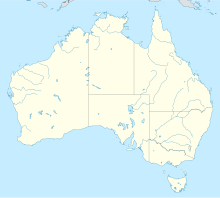 Browns Oxide Project entry gate, 2009 | |
| Location | |
|---|---|
| Location | Batchelor |
| Territory | Northern Territory |
| Country | Australia |
| Coordinates | 12°59′S 131°01′E / 12.983°S 131.017°E |
| Production | |
| Products | Uranium |
| History | |
| Discovered | 1949 |
| Opened | 1950 |
| Closed | 1971 |



Rum Jungle or Unrungkoolpum is a locality in the Northern Territory of Australia, about 105 kilometres south of Darwin on the East Branch of the Finniss River. It is 10 kilometres west of Batchelor[2][3][4] and shares a boundary with Litchfield National Park.
The joint traditional owners of this area are the Kungarakan and Warai peoples, and their rights to the land are recognised in the Finnis River Land Claim, which was granted in May 1981.[5][6]
The European name for this area derives from an incident in March 1873 when miners from the nearby John Bull goldmine met a teamster who was carting stores between Southport and Pine Creek. The teamster tapped a cask of rum that he was carrying and shared it with locals. After waking up from the effects of the teamster's hospitality, they found that he had stolen 750 ounces (21 kg) of their gold, along with their horses, and disappeared. Searches for the thief lasted for a number of months until he and the gold were found.[7][8] The name was first used when reporting the death of Patrick Flynn in November 1873.[9]
Rum Jungle is best known as the site of a uranium deposit, found in 1949, which was mined between 1954 and 1971, producing 3,530 tonnes of uranium oxide, as well as 20,000 tonnes of copper concentrate.[10]
- ^ Australian Bureau of Statistics (27 June 2017). "Rum Jungle (State Suburb)". 2016 Census QuickStats. Retrieved 28 June 2017.
- ^ "About the Kungarakan Culture & Education Association". Kungarakan Culture & Education Association. Retrieved 4 June 2024.
- ^ "Rum Jungle uranium mine opens | Australia's Defining Moments Digital Classroom | National Museum of Australia". digital-classroom.nma.gov.au. Retrieved 5 June 2024.
- ^ "Rum Jungle uranium mine". National Museum of Australia. Retrieved 5 June 2024.
- ^ Government, Northern Territory (27 March 2024). "Rum Jungle History". NT.GOV.AU. Retrieved 4 June 2024.
- ^ Australia. Office of the Aboriginal Land Commissioner (1982), Finniss River land claim : report, Government Printer, ISBN 978-0-644-01874-6
- ^ Beatty, Bill (2 August 1947). "There's drama & tragedy in place names". The Sydney Morning Herald. p. 8. Retrieved 18 October 2015.
- ^ "Rum Jungle". NT Place Names Register. Retrieved 4 June 2024.
- ^ "Northern Territory Times". Northern Territory Times and Gazette. Vol. I, no. 4. Northern Territory, Australia. 28 November 1873. p. 2. Retrieved 5 June 2024 – via National Library of Australia.
- ^ "Rum Jungle". Department of Mines and Energy. Northern Territory Government. 2013. Archived from the original on 1 April 2015. Retrieved 1 May 2015.


